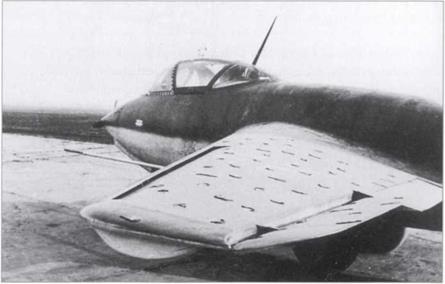The Last Hope – Heimatschiitzer – The Protectors of the Homeland
As further development of midget fighters, special aircraft and manned rockets had not provided the hoped-for results, at the end of 1944 the Chief-TLR turned to more reliable machines. A significandy improved Me 163 had greater range and a retractable undercarriage to make it easier to handle, but, as its potential was seen as limited, the Me 262 Heimatschiitzer also received fresh impetus.
Ju248 – Further Development of the Me 263
The Ju 248 was the Me 263 renamed, the work having been passed to Junkers because the Me 262 had exhausted Messerschmitt’s capacity. In view of the tactical successes of the Me 163, OKL had decided on an improved version with
|
The Ju 248 was a major improvement of the former Me 163. Designated originally as Me 263, it was produced in ones and twos and tested in central Germany at the beginning of 1945. |

longer endurance and a retractable undercarriage. The new machine, equipped with a more powerful rocket motor, was based on experience with the Me 163 В and was developed by Junkers as the Ju 248 from the late summer of 1944. The line was set up at Dessau Slid Waggonfabrik at the end of the year. The first wings were to be manufactured by 10 January 1945 at Puklitz/Zeitz, while the firms of Kronprinz and VDM were responsible for the undercarriage. Many of the other parts were duplicates from the Me 163 B. However, the fuselage would not take the Walter engine and had to be extended by 0.5 metres, thus ruining the timetable.
On 13 January OKL pressed hard for the series run even though work on the first experimental machines had come to a halt, and therefore on 29 January OKL considered abandoning the whole project: JG 400 would receive the He 162 in the short term. The decision was reversed at the beginning of February when the first prototype, Ju 248 V-l, was ready and Flugkapitan Pancherz flew it on 8 February under tow by a Bf 110 (pilot Karl Went). After a second test flight, Pancherz flew six more times on 11 and 13 February and by 19 February the aircraft had been in the air on 13 occasions.
On 7 March the Junkers engineers admitted that the Ju 248 was not so well ahead as might appear, for example the Walter motor ordered for Ju 248 V-2 had not arrived. The daily air raids on the Junkers Werke had destroyed many documents including material being prepared for the Japanese. By mid-March 1945 the undercarriage, part of the electrical system and some instruments were still awaited. In view of the fact that rocket fuels could not be produced in sufficient amounts, on 20 March OKL decided that the Me 263 would have to be cancelled, leaving the field theoretically to the He 162. Three days later Junkers Dessau advised the Chief-TLR that the Walter motor had finally been mounted in the first prototype, but important elements were still missing so that the first rocket-powered ascent was now postponed to the end of the month, and ultimately no test was possible because the front line arrived at Dessau. Most of the documents were destroyed at Ragun School to thwart their seizure by US forces. At least one of the two Me 263s had been blown up shortly before. Dessau was occupied on 24 April 1945.











